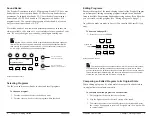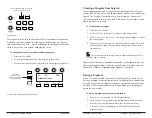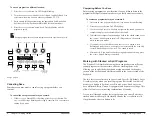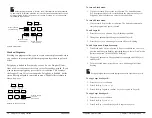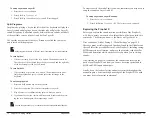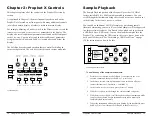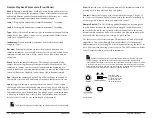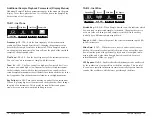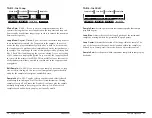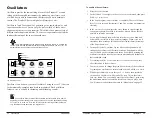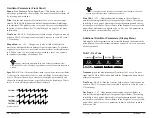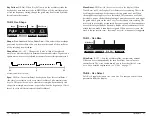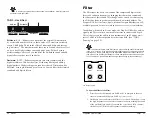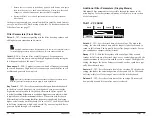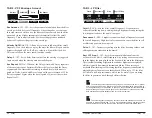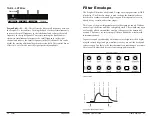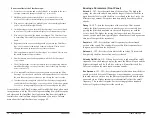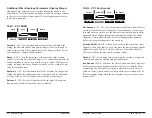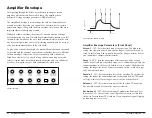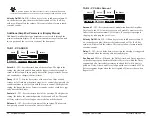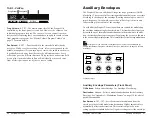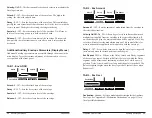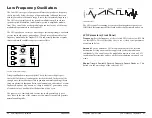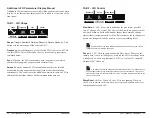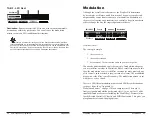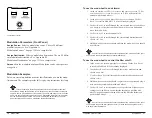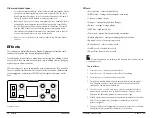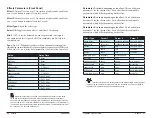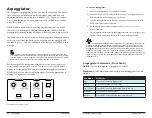
32
33
Filter
Sequential
Prophet X User’s Guide
Filter
3. Return the
cutoff
knob to its halfway position, hold down a note again
then turn the
resonance
knob about halfway up. Notice how the sound
changes as a band of frequencies near the cutoff is amplified.
4.
Rotate the filter’s
cutoff
knob again and listen to a classic resonant
filter sweep.
In the previous example, you controlled the filter cutoff by hand. In most
cases, you will use the Filter Envelope to do this. To learn more about the
Filter Envelope see page 37.
Filter Parameters (Front Panel)
Drive:
0...127
—Increases signal input to the filter, boosting volume and
adding harmonic saturation and warmth.
Sampled instruments have a Boost parameter (in the
inst
misc
tab) that is useful
for increasing signal level to the filter if necessary. This can enhance filter Drive.
Cutoff:
0...164
—Sets the filter’s cutoff frequency. Frequencies are
reduced from the top down, cutting the high frequencies and passing the
low frequencies, hence the name “low-pass.”
Resonance:
0...255
—Emphasizes a narrow band of frequencies around
the cutoff frequency. High levels of resonance can cause the filter to self-
oscillate and generate its own pitch.
High levels of resonance can sometimes cause the Prophet X outputs to clip.
Monitor your outputs carefully to ensure optimal, clean signal levels.
Key Track:
0...127
—Sets the amount of modulation from the keyboard
to the filter’s cutoff frequency. Any setting above zero means that the
higher the note played on the keyboard, the more the filter opens. This
is useful for adding brightness to a sound as higher notes are played, which
is typically how acoustic instruments behave. When set to zero, keyboard
filter tracking is off, meaning that filter frequency is unaffected by playing
higher or lower notes on the keyboard. When set to 127, the filter will track
in half-step increments, which can be useful if you are using the filter to
generate a pitch through self-oscillation.
Additional Filter Parameters (Display Menus)
Additional Filter parameters are accessible through the menus in the
main display. To see these menus, adjust any of controls in
filter
section
of the front panel.
TAB 1 - VCF ADSR
A:25
Attack
Sustain
Decay
Release
D:36
R:44
S:52
LP Filter
LPF Misc
VCF Env Amt
VCF ADSR
Attack:
0...127
—Sets the attack time of the envelope. The higher the
setting, the slower the attack time and the longer it takes for a sound to
reach its full volume. Pads typically have softer (longer) attacks. Percus-
sive sounds have sharper (shorter) attacks.
Decay:
0...127
—Sets the decay time of the envelope. After a sound
reaches its full volume at its attack stage,
decay
controls how quickly the
sound transitions to the level set with the
sustain
control. The higher the
setting, the longer the decay. Percussive sounds, such as synth bass, typi-
cally have shorter decays.
Sustain:
0...127
—Sets the sustain level of the envelope. The higher the
setting, the louder the sustained portion of the sound will be. The sound
will stay at this level for as long as a note is held on the keyboard.
Release:
0...127
—Sets the release time of the envelope. This controls
how quickly a sound dies out after a note is released.

